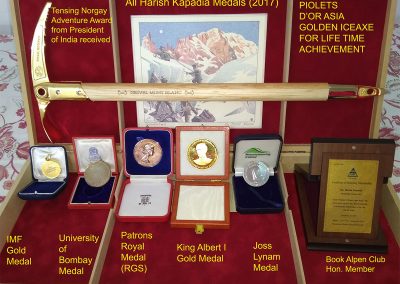
Camping in Kashmir
Peace Climb
Swiss Summit for Siachen
Between 24 and 29 August 2002, a team composed of Harish Kapadia and Mandip Singh Soin from India, Sher Khan and Nazir Sabir from Pakistan, Jamie Andrew from Scotland, and Julie-Ann Clyma and Roger Payne representing the UIAA, climbed several peaks in the Swiss Alps, notably the Monch (4099m). The purpose of the IUCN/UIAA supported climb was to underline the importance of protecting mountain environments and to highlight the success of the Swiss Government in achieving UNESCO natural World Heritage status for the Jungfrau-Aletsch-Bietschhorn region. The climb also promoted the creation of transboundary protected areas, in particular for the Siachen Glacier between India and Pakistan, the scene of the longest running military conflict in the world.
During the Swiss Summit the team met with Adolf Ogi, Special Adviser to the United Nations Secretary General on Sport for Development and Peace. Mr Ogi of Switzerland said: “As mountaineers you have shown the way that I hope others will follow to promote peace through sport”.
Achim Steiner, IUCN Director General noted: “Mountain ecosystems are extremely important, providing home to one tenth of the world’s people, serving as the water towers of the world, and harbouring much of the world’s biological diversity. Yet one of the greatest obstacles to sustainable mountain development today is warfare. IUCN hopes that this award will highlight the urgent need for transboundary cooperation in mountains for peace and conservation.”
The IIPT Global Summit is dedicated to building a culture of peace through tourism and includes a special panel on the role of sport in promoting peace. Roger Payne, the sport and development director of the UIAA, who collected the achievement award with Jamie Andrew, said: “In collecting this award we thank IIPT and we must pay tribute to those in India and Pakistan who have raised the issue of protecting the Siachen Glacier. Let us hope that their commitment to goodwill and cooperation through sport will influence the decision makers and help overcome the barriers that separate India and Pakistan in the high mountains of Asia. The UIAA and IUCN are both willing to support efforts towards establishing a Siachen Glacier transboundary protected area for cooperation, conservation and peace.”
Swiss Summit: A report with quotations from members of the team and photographs is at www.uiaa.ch/iucn/ & http://iucn.org/themes/wcpa/biome/mountain/mountain.html
Siachen Glacier Peace Park: The Siachen Glacier is the longest glacier in the world. Since 1984 the armed forces of India and Pakistan have fought over the Saltoro Ridge with advanced posts up to 6700m. This is the highest battlefield in the world and the longest running military armed conflict, costing an estimated USD 1 million per day on the India side alone. The conflict has become a stalemate. All the spent munitions and waste from the two armies drains into the glaciers and eventually into the Indus River. Initiating an environmental clean up operation on the Siachen Glacier could help to resolve the dispute over the mountain border and to establish a peace park to protect the glaciers and rivers, which provide waters to millions of people, from further pollution.
Transboundary Protected Areas for Peace and Cooperation: IUCN’s Programme on Protected Areas and the IUCN World Commission on Protected Areas (WCPA), the biggest world network of protected areas experts, have been working on a Peace Parks Initiative for many years through its Working Group on Transboundary Protected Areas and an ad-hoc group for a Siachen Glacier Peace Park. In 2001, “Best practice guidelines for Transboundary Protected Areas for Peace and Cooperation” were published, highlighting the benefits of such areas and providing an approach for establishing peace parks. Transboundary protected areas will be one of the focuses of IUCN’s Vth World Parks Congress to be held in Durban, South Africa, 8-17 September 2003. More information on the Congress from www.iucn.org/wpc2003.
Created in 1948, IUCN – The World Conservation Union brings together 72 States, 107 government agencies, 743 NGOs, 34 affiliates, and some 10,000 scientists and experts from 181 countries in a unique worldwide partnership. IUCN’s mission is to influence, encourage and assist societies throughout the world to conserve the integrity and diversity of nature and to ensure that any use of natural resources is equitable and ecologically sustainable. IUCN is the world’s largest environmental knowledge network and has helped over 75 countries to prepare and implement national conservation and biodiversity strategies. IUCN is a multicultural, multilingual organization with 1000 staff located in 42 countries. Its headquarters are in Gland, Switzerland. More information on IUCN’s work from www.iucn.org
Created in 1932, UIAA – The International Mountaineering and Climbing Federation has 91 members association is 67 different countries which collectively represent 2.5 million participants. The UIAA has expertise in the practice of all mountain sports, youth activities and competitions; links responsible access with protection of the environment; gives guidance on ethics, good practice and safety; conducts research into mountain medicine; and sets international standards for safety equipment and instructor training. More information on the UIAA’s work to promote cooperation and peace, protection of the environment and sporting excellence is available from www.uiaa.ch/proposals













